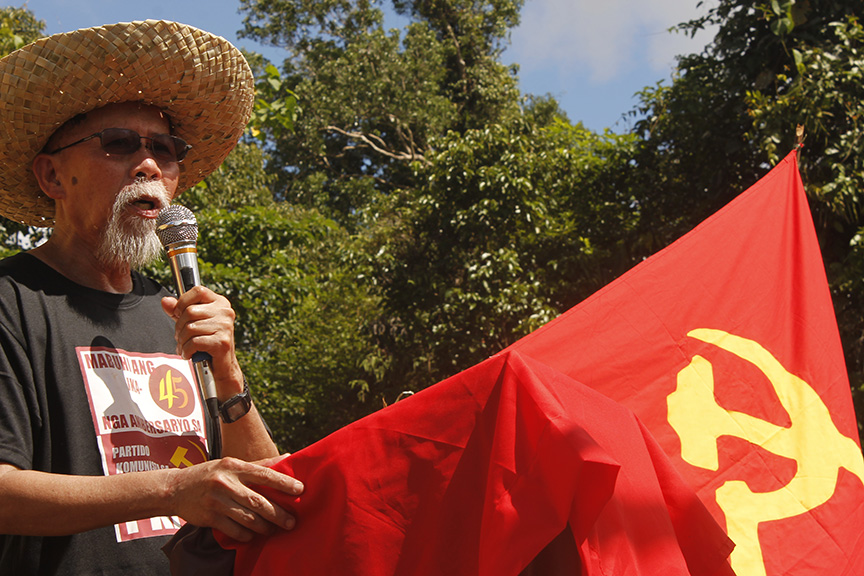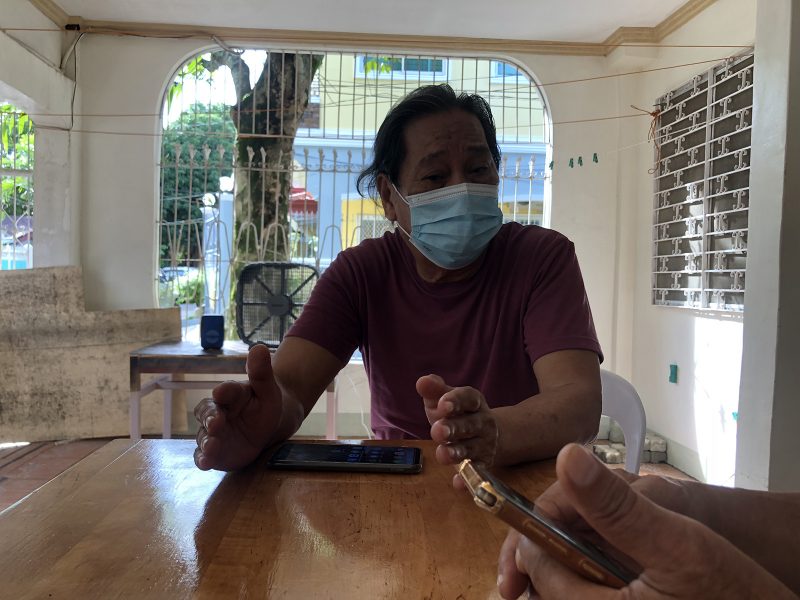From MindaNews (Nov 4, 2021): Brother of Ka Oris doubts claims slain rebel leader was positive for COVID-19

NPA spokesperson Jorge “Ka Oris” Madlos. MindaNews file photo by ARIES SANDINO M. MORDENO
A brother of Jorge “Ka Oris” Madlos expressed doubts that the slain New People’s Army (NPA) leader contracted COVID-19 and had to be cremated, saying the military in Bukidnon did not disclose the whereabouts of his body when their youngest sibling went there to claim it.
Vicente Madlos, an elder brother of Ka Oris, said his brother Rito went to the place where the NPA leader was reportedly found dead and to military camps in the province, to no avail.
He said Rito got no information on where the remains were taken during the two days that he was in Bukidnon.
The 72-year-old, Siargao-born rebel leader was killed on Friday, October 29, along with an aide, in what the military claimed to be a clash between rebel and government forces in Sitio Gabunan, Barangay Dumalaguing, Impasug-ong, Bukidnon. The military said their bodies were recovered the following day.
The National Democratic Front (NDF) refuted this claim, saying the ailing Ka Oris and his medical aide, identified by the military as Eighfel Dela Peña, were killed in an ambush on Friday night.
According to Ka Oris’ wife, Maria Malaya, NDF spokesperson for Northeast Mindanao, his husband and Dela Peña were on a motorcycle on their way to get medical treatment, and never reached the highway.
Vicente, speaking to local reporters on Wednesday, said he was also dismayed to know that Ka Oris’s remains were cremated on Tuesday after swab samples taken from his body supposedly tested positive for COVID-19 based on tests by the Philippine Red Cross’s molecular laboratory.
The remains were cremated Tuesday afternoon at the crematorium of the Divine Shepherd Memorial Chapels in Bulua, Cagayan de Oro City, according to Divine Shepherd documents provided by the military.
Brig. Gen. Ferdinand Barandon, commander of the 403rd Infantry Brigade based in Malaybalay City, said it has been standard operating procedure for the military to test captured or killed New People’s Army rebels for COVID-19 after many of the guerillas were found positive following a series of encounters in Bukidnon last September.
“No one among the family was informed with this,” he said.
A brother of Jorge “Ka Oris” Madlos expressed doubts that the slain New People’s Army (NPA) leader contracted COVID-19 and had to be cremated, saying the military in Bukidnon did not disclose the whereabouts of his body when their youngest sibling went there to claim it.
Vicente Madlos, an elder brother of Ka Oris, said his brother Rito went to the place where the NPA leader was reportedly found dead and to military camps in the province, to no avail.
He said Rito got no information on where the remains were taken during the two days that he was in Bukidnon.
The 72-year-old, Siargao-born rebel leader was killed on Friday, October 29, along with an aide, in what the military claimed to be a clash between rebel and government forces in Sitio Gabunan, Barangay Dumalaguing, Impasug-ong, Bukidnon. The military said their bodies were recovered the following day.
The National Democratic Front (NDF) refuted this claim, saying the ailing Ka Oris and his medical aide, identified by the military as Eighfel Dela Peña, were killed in an ambush on Friday night.
According to Ka Oris’ wife, Maria Malaya, NDF spokesperson for Northeast Mindanao, his husband and Dela Peña were on a motorcycle on their way to get medical treatment, and never reached the highway.
Vicente, speaking to local reporters on Wednesday, said he was also dismayed to know that Ka Oris’s remains were cremated on Tuesday after swab samples taken from his body supposedly tested positive for COVID-19 based on tests by the Philippine Red Cross’s molecular laboratory.
The remains were cremated Tuesday afternoon at the crematorium of the Divine Shepherd Memorial Chapels in Bulua, Cagayan de Oro City, according to Divine Shepherd documents provided by the military.
Brig. Gen. Ferdinand Barandon, commander of the 403rd Infantry Brigade based in Malaybalay City, said it has been standard operating procedure for the military to test captured or killed New People’s Army rebels for COVID-19 after many of the guerillas were found positive following a series of encounters in Bukidnon last September.
“No one among the family was informed with this,” he said.

Vicente Madlos, elder brother of slain NPA leader Jorge “Ka Oris” Madlos, during a talk with reporters in Surigao City on Wednesday (Nov. 3, 2021). MindaNews photo by ROEL N. CATOTO
Maj. Gen. Romeo Brawner Jr., commander of the Army’s 4th Infantry Division, said the Inter-Agency Task Force (IATF) of Impasugong brought KA Oris’s body from the encounter site in Sitio Gabunan to the Divine Shepherd crematorium.
He said the IATF took over the disposal of the remains after the reverse transcription polymerase chain reaction (RT-PCR) test on the swab samples turned out to be positive.
Maj. Gen. Albert Ignatius Ferro, chief of the National Criminal Investigation and Detection Group, said the Philippine National Police would allow the family of Ka Oris to retrieve the urn of ashes.
“How are we so sure that the ashes they will be giving to us belonged to Ka Oris?” Vicente asked.
Unfinished studies
Ka Oris studied at Central Mindanao University in Musuan, Bukidnon but did not finish his Agricultural Engineering. Like many other student activists, he went underground after the declaration of Martial Law in September 1972.
He had two children with Maria Malaya, Vincent Isagani and Malaya.
“Both grew up with me as their foster father, one is in in United States of America as a nurse while the other one was a call center worker in Cebu,” Vicente said.
But Vincent Isagani, the call center worker, was forced to go into hiding after he was “maliciously charged” for alleged involvement in the NPA’s simultaneous raids of mining companies in Claver, Surigao del Norte in 2011, he said.
Vicente also recalled that in 1980, their elder brother, Salvador, was stabbed to death aboard a Philtranco bus on his way to Cagayan de Oro City for a work at the Ministry of Education, now the Department of Education.
“Salvador was mistaken as Jorge because he looked like him,” he said.
Fernando Almeda Jr., a retired port manager and president of Surigaonon Heritage Center called Ka Oris a deep thinker.
“His leadership in the underground movement is something incomparable,” he added.
Ka Oris was detained in Camp Crame from 1989 to 1991.
The late mayor of General Luna town in Siargao Island Jaime Rusillon, in a conversation with this reporter, recalled that after his release Ka Oris borrowed money from him for an “important trip”.
Rusillon said he gave Ka Oris a hefty amount thinking he would go to Manila to find a job only to learn later that he returned to the underground.
“We heard him over the radio interviews, Jorge would really die for his cause,” he said.
https://www.mindanews.com/top-stories/2021/11/brother-of-ka-oris-doubts-claims-slain-rebel-leader-was-positive-for-covid-19/
Maj. Gen. Romeo Brawner Jr., commander of the Army’s 4th Infantry Division, said the Inter-Agency Task Force (IATF) of Impasugong brought KA Oris’s body from the encounter site in Sitio Gabunan to the Divine Shepherd crematorium.
He said the IATF took over the disposal of the remains after the reverse transcription polymerase chain reaction (RT-PCR) test on the swab samples turned out to be positive.
Maj. Gen. Albert Ignatius Ferro, chief of the National Criminal Investigation and Detection Group, said the Philippine National Police would allow the family of Ka Oris to retrieve the urn of ashes.
“How are we so sure that the ashes they will be giving to us belonged to Ka Oris?” Vicente asked.
Unfinished studies
Ka Oris studied at Central Mindanao University in Musuan, Bukidnon but did not finish his Agricultural Engineering. Like many other student activists, he went underground after the declaration of Martial Law in September 1972.
He had two children with Maria Malaya, Vincent Isagani and Malaya.
“Both grew up with me as their foster father, one is in in United States of America as a nurse while the other one was a call center worker in Cebu,” Vicente said.
But Vincent Isagani, the call center worker, was forced to go into hiding after he was “maliciously charged” for alleged involvement in the NPA’s simultaneous raids of mining companies in Claver, Surigao del Norte in 2011, he said.
Vicente also recalled that in 1980, their elder brother, Salvador, was stabbed to death aboard a Philtranco bus on his way to Cagayan de Oro City for a work at the Ministry of Education, now the Department of Education.
“Salvador was mistaken as Jorge because he looked like him,” he said.
Fernando Almeda Jr., a retired port manager and president of Surigaonon Heritage Center called Ka Oris a deep thinker.
“His leadership in the underground movement is something incomparable,” he added.
Ka Oris was detained in Camp Crame from 1989 to 1991.
The late mayor of General Luna town in Siargao Island Jaime Rusillon, in a conversation with this reporter, recalled that after his release Ka Oris borrowed money from him for an “important trip”.
Rusillon said he gave Ka Oris a hefty amount thinking he would go to Manila to find a job only to learn later that he returned to the underground.
“We heard him over the radio interviews, Jorge would really die for his cause,” he said.
https://www.mindanews.com/top-stories/2021/11/brother-of-ka-oris-doubts-claims-slain-rebel-leader-was-positive-for-covid-19/

No comments:
Post a Comment
Note: Only a member of this blog may post a comment.